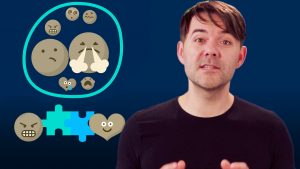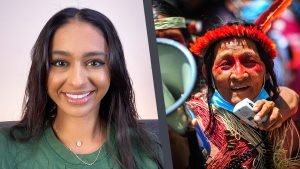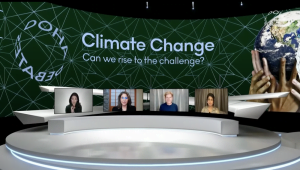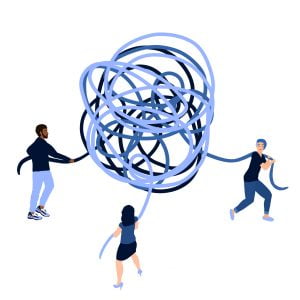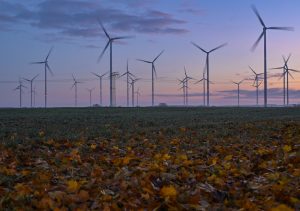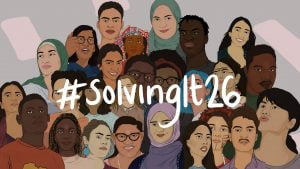
Climate Change: Can we rise to the challenge?
Human activities are changing the climate in unprecedented and, in some cases, irreversible ways. But what are the best solutions to this enormous challenge? Is focusing on renewable resources practical? And how do we balance our global fight against climate change with the myriad other problems plaguing our planet?
01. How alarmist should we be about climate change?
How alarmist should we be about climate change?
Check out this episode from the second season of the Course Correction podcast to start thinking about a full spectrum of perspectives on climate change: the language we use to talk about it; the dollars and cents involved in convincing people to get on board; the economic shift away from fossil fuels and carbon taxing.
Listen to the podcast for a deep dive into these essential questions:
- What can we learn by examining the way we talk about climate change?
- How important is individual action when it comes to climate change?
- Do the biggest contributors to the climate crisis have a moral obligation to lead the world in decarbonization?
- How do policy efforts aimed at combating climate change stack up against other historic political changes?
Full lesson plan for educators: How alarmist should we be about climate change?
02. Climate colonialism
The colonialist roots of climate change
Watch the video and discuss these essential questions before diving into the Map Your Worldview activity.
- If you listened to the podcast in the first lesson about alarmism around climate change, how does the message in this video compare? What is your opinion about the messages we consume in the media and how alarmed we should actually be about climate change?
- What are the geographic, social, demographic and racial factors underlying the “inequality of climate change” discussed in the video?
- What is the connection between climate colonialism, internally displaced persons (IDPs) and carbon offsetting?
- Nelufar mentions “controlled burns” as an example of Indigenous approaches to controlling forest fires — an argument for giving Indigenous wisdom a more central role in combatting climate change. What are your views about the role of Indigenous peoples in climate change?
- In addition to the mitigation alternatives listed at the end of the video, can you think of others you would add?
Consider all these issues — and any others that stood out in the video — as you begin to explore the complex system of climate change and engage in the Map Your Worldview activity.
03. Have a better conversation about climate change
Better Conversations: Understand Their Story
Think about these questions as you engage in the Understand Their Story activity. How does Dr. Clayton’s advice in the video relate to the conversation about climate change?
- Are you directly affected by climate change? What is your story or viewpoint on the issue? What does it feel like when your story or viewpoint is not understood by others?
- Imagine each of the following individual or group perspectives on climate change:
- victims in areas where there are frequent hurricanes or forest fires
- farmers
- a coal miner or oil rig worker
- a coal or oil executive
- a founder of a solar power company
- people who live in a landscape affected by melting glaciers or desertification
- Indigenous peoples who live in harmony with nature
- a biologist studying biodiversity
- a family displaced due to climate change
04. What role do Indigenous groups have in the climate conversation?
#DearWorldLive: Protecting the Earth: Indigenous solutions to the climate crisis
As you watch this episode of #DearWorldLive, pay particular attention to the terminology used by each of the speakers and their comments related to the language around climate change. Be sure to take notes on terms that stand out. Consider the following questions before engaging in the Build a Shared Vocabulary activity:
- What does “climate justice” mean to you?
- Why is storytelling important in conversations about climate change?
- Why is it important to examine the language used to talk about climate change?
- Why are Indigenous voices particularly important when it comes to imagining solutions to climate change?
- Which of the speakers gave you the most to think about, and why?
- Which concepts would you like to know more about?
Consider all of this as you engage in the Build a Shared Vocabulary activity and keep expanding on it in the lead-up to the debate.
05. Engage with the debate
Climate Change: Can we rise to the challenge?
It’s time to watch the climate change debate! Keep the following questions in mind for discussion afterward:
- Which speaker position resonates most strongly with you, and why?
- Is there common ground among the speakers’ positions?
- If you’ve been keeping up with COP26 in Glasgow, how does this debate reflect the decisions being made there?
Explore additional questions in the Watch the Debate activity.
06. Climate change stakeholders
Climate Change: Can we rise to the challenge?
Pay close attention to the speakers’ position statements in the opening segment of the debate, and consider the following questions before engaging in the Stakeholder Review activity that follows.
- Who are the major stakeholders associated with Naomi’s position on the role of capitalism and corporate greed in the climate crisis?
- Who are the stakeholders associated with Bjorn’s position on investing in new technologies and green energy?
- Who are the stakeholders associated with Ameenah’s position on creating fairer policies for all, especially the global south?
- Is there overlap between the stakeholders associated with each position?
- What solutions to the climate crisis does each speaker pose? Whose stakeholders stand to lose and whose stand to gain if these solutions are implemented?
Engage in a deeper discussion in the Stakeholder Review activity.
07. What are the systemic elements of climate change?
Now that you’ve explored the stakeholders involved in the climate crisis, start thinking broadly about all the elements involved in this complex system. Use these questions to guide your brainstorming:
- What are the physical and natural phenomena mentioned during the debate? Can you think of others related to climate change?
- What are some of the pressing social issues caused or exacerbated by climate change, according to the debate panel? Are there others that are not mentioned?
- What political and institutional factors are related to climate change?
- What other complex global problems does climate change impact?
Explore how to organize all these elements and begin to see the system more clearly in the Collect and Cluster activity. Look out for the full unit later this month to go deeper into system mapping.
08. Reflect on the debate and envision change
Reflect on the debate using the following questions before engaging in the Envision Change activity.
- What commonalities in the speakers’ positions did the connector, Govinda Clayton, point out during the debate?
- Did any of the panelists attempt to seek consensus, and if so, how?
- Did you notice any contradictions in the speakers’ positions as the debate progressed?
- Did the speakers offer concrete, convincing and feasible solutions to climate change? Which of their solutions resonated with you?
- What are your own ideas about the changes needed to ensure a livable planet for future generations?
Now reflect on kind of change you want to see in the world — and how you might go about affecting it — in the Envision Change activity.
09. Solving climate change
The youth advocates and activists spotlighted in Doha Debates’ #SolvingIt series are on the front lines of systemic change. As you explore their profiles, think about the following:
- What kind of action (direct or indirect), advocacy or research are these young people engaged in to combat climate change?
- Are their efforts focused on disrupting capitalism, promoting new green technologies, protecting biodiversity, dismantling inequity in the global south, fossil fuel emissions or some other issue of significance in this system?
- Are they aiming for small shifts or sweeping change?
Keep these questions in mind as you engage in the #SolvingIt activity and identify members of your own community who deserve to be celebrated for their efforts to solve the climate crisis.


